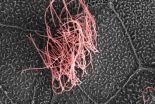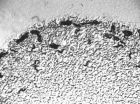(Press-News.org) NASA's Hubble Space Telescope has looked deep into the distant universe and detected the feeble glow of a star that exploded more than 9 billion years ago. The sighting is the first finding of an ambitious survey that will help astronomers place better constraints on the nature of dark energy, the mysterious repulsive force that is causing the universe to fly apart ever faster.
"For decades, astronomers have harnessed the power of Hubble to unravel the mysteries of the universe," said John Grunsfeld, associate administrator for NASA's Science Mission Directorate in Washington. "This new observation builds upon the revolutionary research using Hubble that won astronomers the 2011 Nobel Prize in Physics, while bringing us a step closer to understanding the nature of dark energy which drives the cosmic acceleration." As an astronaut, Grunsfeld visited Hubble three times, performing a total of eight spacewalks to service and upgrade the observatory.
The stellar explosion, nicknamed SN Primo, belongs to a special class called Type Ia supernovae, which are bright beacons used as distance markers for studying the expansion rate of the universe. Type Ia supernovae likely arise when white dwarf stars, the burned-out cores of normal stars, siphon too much material from their companion stars and explode.
SN Primo is the farthest Type Ia supernova with its distance confirmed through spectroscopic observations. In these types of observations, a spectrum splits the light from a supernova into its constituent colors. By analyzing those colors, astronomers can confirm its distance by measuring how much the supernova's light has been stretched, or red-shifted, into near-infrared wavelengths because of the expansion of the universe.
The supernova was discovered as part of a three-year Hubble program to survey faraway Type Ia supernovae, opening a new distance realm for searching for this special class of stellar explosion. The remote supernovae will help astronomers determine whether the exploding stars remain dependable cosmic yardsticks across vast distances of space in an epoch when the cosmos was only one-third its current age of 13.7 billion years.
Called the CANDELS+CLASH Supernova Project, the census uses the sharpness and versatility of Hubble's Wide Field Camera 3 (WFC3) to assist astronomers in the search for supernovae in near-infrared light and verify their distance with spectroscopy. CANDELS is the Cosmic Assembly Near-infrared Deep Extragalactic Legacy Survey and CLASH is the Cluster Lensing and Supernova Survey.
"In our search for supernovae, we had gone as far as we could go in optical light," said Adam Riess, the project's lead investigator, at the Space Telescope Science Institute and The Johns Hopkins University in Baltimore, Md. "But it's only the beginning of what we can do in infrared light. This discovery demonstrates that we can use the Wide Field Camera 3 to search for supernovae in the distant universe."
The new results were presented on Jan. 11 at the American Astronomical Society meeting in Austin, Texas.
The supernova team's search technique involved taking multiple near-infrared images over several months, looking for a supernova's faint glow. After the team spotted the stellar blast in October 2010, they used WFC3's spectrometer to verify SN Primo's distance and to decode its light, finding the unique signature of a Type Ia supernova. The team then re-imaged SN Primo periodically for eight months, measuring the slow dimming of its light.
By taking the census, the astronomers hope to determine the frequency of Type Ia supernovae during the early universe and glean insights into the mechanisms that detonated them.
"If we look into the early universe and measure a drop in the number of supernovae, then it could be that it takes a long time to make a Type Ia supernova," said team member Steve Rodney of The Johns Hopkins University. "Like corn kernels in a pan waiting for the oil to heat up, the stars haven't had enough time at that epoch to evolve to the point of explosion. However, if supernovae form very quickly, like microwave popcorn, then they will be immediately visible, and we'll find many of them, even when the universe was very young. Each supernova is unique, so it's possible that there are multiple ways to make a supernova."
If astronomers discover that Type Ia supernovae begin to depart from how they expect them to look, they might be able to gauge those changes and make the measurements of dark energy more precise. Riess and two other astronomers shared the 2011 Nobel Prize in Physics for discovering dark energy 13 years ago, using Type Ia supernova to plot the universe's expansion rate.
INFORMATION:
The Hubble Space Telescope is a project of international cooperation between NASA and the European Space Agency. NASA's Goddard Space Flight Center manages the telescope. The Space Telescope Science Institute (STScI) conducts Hubble science operations. STScI is operated for NASA by the Association of Universities for Research in Astronomy, Inc., in Washington, D.C.
For images and more information about Hubble, visit:
http://www.nasa.gov/hubble
Hubble breaks new ground with discovery of distant exploding star
2012-01-13
ELSE PRESS RELEASES FROM THIS DATE:
LSU professor discovers world's tiniest vertebrate
2012-01-13
BATON ROUGE – LSU's Chris Austin recently discovered two new species of frogs in New Guinea, one of which is now the world's tiniest known vertebrate, averaging only 7.7 millimeters in size – less than one-third of an inch. It ousts Paedocypris progenetica, an Indonesian fish averaging more than 8 millimeters, from the record. Austin, leading a team of scientists from the United States including LSU graduate student Eric Rittmeyer, made the discovery during a three-month long expedition to the island of New Guinea, the world's largest and tallest tropical island.
"It ...
New species of tiny frog is world's smallest vertebrate
2012-01-13
Researchers have found two new frog species in New Guinea, one of which is the new smallest known vertebrate on Earth. The results are reported in the Jan. 11 issue of the online journal PLoS ONE, and the team of researchers was led by Christopher Austin of Louisiana State University.
The new smallest vertebrate species is called Paedophryne amauensis, named after Amau Village in Papua New Guinea, where it was found. The adult body size for these frogs ranges from just 7.0 to 8.0 millimeters.
According to Dr. Austin, the discovery "is of considerable interest to biologists ...
Selectively stopping glutathione sensitizes brain tumors to chemotherapy
2012-01-13
Brain cancer cells are particularly resistant to chemotherapy — toxins enter the cells, but before the toxins can kill, cancer cells quickly pump them back outside. In fact, brain cancer cells are even better than healthy cells at cleaning themselves. This means that when hit with chemotherapy, healthy cells tend to die before brain cancer cells. Especially in the brain, killing healthy cells is bad.
Researchers at the University of Colorado Cancer Center have discovered a way to turn off the pumps — only in brain cancer cells and not in their healthy neighbors. Promising ...
Diet counts: Iron intake in teen years can impact brain in later life
2012-01-13
Iron is a popular topic in health news. Doctors prescribe it for medical reasons, and it's available over the counter as a dietary supplement. And while it's known that too little iron can result in cognitive problems, it's also known that too much promotes neurodegenerative diseases.
Now, researchers at UCLA have found that in addition to causing cognitive problems, a lack of iron early in life can affect the brain's physical structure as well.
UCLA neurology professor Paul Thompson and his colleagues measured levels of transferrin, a protein that transports iron ...
Scientists identify gene crucial to normal development of lungs and brain
2012-01-13
La Jolla ---- Scientists at the Salk Institute for Biological Studies have identified a gene that tells cells to develop multiple cilia, tiny hair-like structures that move fluids through the lungs and brain. The finding may help scientists generate new therapies that use stem cells to replace damaged tissues in the lung and other organs.
"Cells with multiple cilia play a number of important roles, including moving fluids through the respiratory tract, brain and spinal cord," says Christopher R. Kintner, a professor in Salk's Molecular Neurobiology Laboratory, who led ...
Worm seeks worm: Caltech researchers find chemical cues driving aggregation in nematodes
2012-01-13
PASADENA, Calif.— Scientists have long seen evidence of social behavior among many species of animals, both on the earth and in the sea. Dolphins frolic together, lions live in packs, and hornets construct nests that can house a large number of the insects. And, right under our feet, it appears that nematodes—also known as roundworms—are having their own little gatherings in the soil. Until recently, it was unknown how the worms communicate to one another when it's time to come together. Now, however, researchers from the California Institute of Technology (Caltech) and ...
Discovery could help stem smoking-related diseases
2012-01-13
Sufferers of smoking related lung diseases could have their debilitating symptoms reduced following the discovery of a potential new treatment.
The discovery, by researchers at the University of Melbourne, Royal Melbourne Hospital, Australia, and the Brigham and Women's Hospital, Harvard Medical School, US, could dramatically improve treatments and slow the progression of COPD (Chronic Obstructive Pulmonary Disease) which includes the incurable condition emphysema.
COPD is a progressive disease that makes it hard to breathe and is mostly caused by excessive smoking. ...
Grapes may help prevent age-related blindness
2012-01-13
FRESNO, Calif. – Can eating grapes slow or help prevent the onset of age-related macular degeneration (AMD), a debilitating condition affecting millions of elderly people worldwide? Results from a new study published in Free Radical Biology and Medicine suggest this might be the case. The antioxidant actions of grapes are believed to be responsible for these protective effects.
The study compared the impact of an antioxidant-rich diet on vision using mice prone to developing retinal damage in old age in much the same way as humans do. Mice either received a grape-enriched ...
In tackling lead pollution, fungi may be our friends
2012-01-13
Fungi may be unexpected allies in our efforts to keep hazardous lead under control. That's based on the unexpected discovery that fungi can transform lead into its most stable mineral form. The findings reported online on January 12 in Current Biology, a Cell Press publication, suggest that this interaction between fungi and lead may be occurring in nature anywhere the two are found together. It also suggests that the introduction or encouragement of fungi may be a useful treatment strategy for lead-polluted sites.
"Lead is usually regarded as a pretty stable substance," ...
Boston College researchers locate protein that could 'turn off' deadly disease carrier
2012-01-13
CHESTNUT HILL, MA (Jan. 12, 2012) – Researchers from Boston College have discovered a protein that plays a pivotal role in the progression of the deadly diseases toxoplasmosis and malaria and shown that its function could be genetically blocked in order to halt the progress of the parasite-borne illnesses, the team reports in the current edition of the journal Science.
The protein, identified as DOC2.1, plays a similar role in the secretion of microneme organelles that are crucial to the mobility of the parasitic protozoa Toxoplasma gondii, which causes toxoplasmosis, ...


